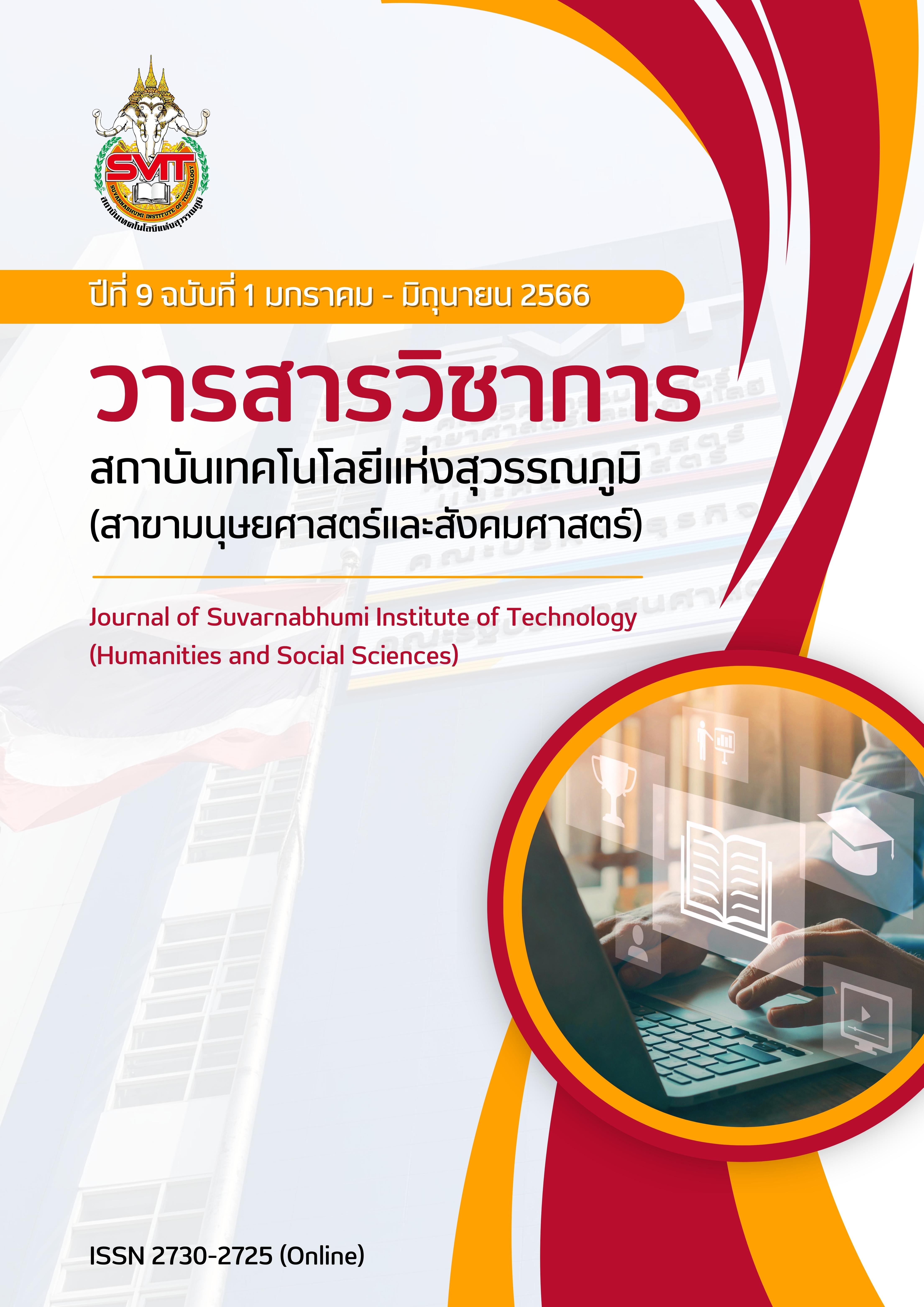21 st CENTURY LEADERSHIP OF SCHOOL ADMINISTRATORS AFFECTING THE MOTIVATION AND PERFORMANCE OF TEACHERS IN SCHOOLS UNDER SAMUT PRAKAN PRIMARY EDUCATIONAL SERVICE AREA OFFICE 1
Keywords:
21st Century leadership of school administrators, teacher’s motivation and performanceAbstract
This research aimed to study 1) the leadership level of school administrators in the 21st century, 2) the motivation level of teachers, 3) the relationship of school administrators in the 21st century that influences the motivation of teachers under the Samut Prakan Primary Educational Service Area 1. The samples were 327 teachers from Samut Prakan Primary Educational Service Area 1, The research instruments were 5 rating scales of questionnaire. The questionnaire has a reliability of 0.93. The statistics for data analysis comprised of percentage, mean, standard deviation, Alpha coefficient, ANOVA, stepwise and multiple regression.
The research found that the 21st century educational leadership prediction influenced the motivation of teachers in Samut Prakan Primary Educational Service Area 1 found that 1) 21st century leadership level was the highest, both overall and in all aspects. In all aspects, 3) the level of leadership of educational institutions in the 21st century that influences teachers' motivation to operate. Samut Prakan Primary Educational Service Area 1 statistically significant at .01, creating a predictive equation in raw score form, tot = 1.054 + 0.774 X and a predictive equation in standard score form
Ytot = 0.725Zx. This shows that the leadership of 21st century school administrators changed by one unit. Samut Prakan Primary Educational Service Area 1 changed to 0.725 units.
References
กรรณจริยา สุขรุ่ง และคณะ. (2558). ผู้นำที่แท้แห่งศตวรรษที่ 21. นครปฐม: ภาพพิมพ์.
กระแส ชนะวงศ์. (2556). ภาวะผู้นำ. สืบค้นจาก http://www.hham.or.th/content/100/1/.com.
กระทรวงศึกษาธิการ. (2555). แผนพัฒนาการศึกษาของกระทรวงศึกษาธิการฉบับที่ 11 พ.ศ. 2555-2559. กรุงเทพฯ: ผู้แต่ง.
จีระ หงส์ลดารมภ์. (2556). การพัฒนาภาวะผู้นํา. สืบค้นจาก http://www.chiraucaclemy.com.
พูลสุข ธรรมสุนทร. (2556). ความสัมพันธ์ระหว่างภาระผู้นําการเปลี่ยนแปลงของผู้บริหารโรงเรียนกับความพึงพอใจในการปฏิบัติงานของครูผู้สอน เครือข่ายตากสิน
สังกัด สำนักงานเขตพื้นที่การศึกษาระยอง เขต 1. (วิทยานิพนธ์ปริญญามหาบัณฑิต, มหาวิทยาลัยบูรพา)
พรชัย เจดามาน. (2559). ภาวะผู้นำการเปลี่ยนแปลง ศตวรรษที่ 21: ไทยแลนด์ 4.0. สืบค้นจากhttp://www.cmld-rmu.com/index.php/article/9
articles/142-21-4-0
พระธรรมปิฎก. (2553). พจนานุกรมพุทธศาสตร์ ฉบับประมวลธรรม. กรุงเทพฯ: สหธรรมิก.
ไพฑูรย์ สินลารัตน์. (2555). ออกแบบผู้นําการศึกษาใหม่: ผู้นําเชิงสร้างสรรค์และผลิตภาพ. กรุงเทพฯ: วิทยาลัยครุศาสตร์ มหาวิทยาลัยธุรกิจบัณฑิต.
วิจารณ์ พานิช. (2555). วิถีสร้างการเรียนรู้เพื่อศิษย์ในศตวรรษที่ 21. กรุงเทพฯ: มูลนิธิสดศรี สฤษดิ์วงศ์.
วิโรจน์ สารรัตนะ. (2556). กระบวนทัศน์ใหม่ทางการศึกษา กรณีทัศนะต่อการศึกษาศตวรรษที่ 21.กรุงเทพฯ: ทิพยาสุทธิ์
ศศิมาศ หอมบุญมา. (2558). แรงจูงใจในการทำงานที่ส่งผลต่อความผูกพันต่อโรงเรียนของครู โรงเรียนกลุ่มโรงเรียนมหาชัย สังกัดสำนักงานเขตพื้นที่การศึกษา
ประถมศึกษา สมุทรสาคร. (วิทยานิพนธ์ปริญญามหาบัณฑิต, มหาวิทยาลัยบูรพา)
ศรีธารา แหยมคง. (2557). ทักษะการเป็นผู้นําฯ. กรุงเทพฯ: ม.ป.ท.
สันติ บุญภิรม. (2552). หลักการบริหารการศึกษา. กรุงเทพฯ: ไทยร่มเกล้า.
สุทัศน์ สังคะพันธ์. (2557). “ทําไมต้องทักษะในศตวรรษที่ 21” ใน บทความทักษะแห่งศตวรรษที่ 21.
มหาสารคาม: มหาวิทยาลัยมหาสารคาม.
สุมาพร ทำทอง. (2554). ภาวะผู้นําของผู้บริหารโรงเรียนตามทัศนะของครูผู้สอนโรงเรียนในกลุ่ม
วิภาวดี สังกัดกรุงเทพมหานคร. (วิทยานิพนธ์ปริญญามหาบัณฑิต, มหาวิทยาลัยราชภัฏพระนคร)
สมหมาย โอภาษี. (2558). ความสัมพันธ์ระหว่างภาวะผู้นําการเปลี่ยนแปลงของผู้บริหารโรงเรียน กับความพึงพอใจในการปฏิบัติงานของครูสังกัดสำนักงานเขต
พื้นที่การศึกษาจันทบุรี เขต 1. (วิทยานิพนธ์ปริญญามหาบัณฑิต, มหาวิทยาลัยราชภัฏรำไพพรรณี)
สำนักงานเขตพื้นที่การศึกษาประถมศึกษาสมุทรปราการ เขต 1. (2563). รายงานผลการดำเนินการ ปีงบประมาณ 2563. สมุทรปราการ: ผู้แต่ง.
สำนักงานคณะกรรมการพัฒนาการเศรษฐกิจและสังคมแห่งชาติ. (2559). แผนพัฒนาเศรษกิจและสังคมแห่งชาติ ฉบับที่สิบสอง พ.ศ. 2560-2564. สืบค้นจาก
http://www.nesdb.go.th/ewt_dl_ling.php?nid=6422.
อัชยา คิสาลัง วาโร เพ็งสวัสดิ์ และศิริดา บุรชาติ. (2554). ความสัมพันธ์ระหว่างภาวะผู้นำการเปลี่ยนแปลงของผู้บริหารกับความพึงพอใจในการปฏิบัติงานของครูใน
โรงเรียน สังกัดเทศบาลเมืองนครพนม. (วิทยานิพนธ์ปริญญามหาบัณฑิต, มหาวิทยาลัยนครพนม)
Adair.J. (2007). Leadership for innovation: How to organize team creativity and harvest ideas. London: Kogan Page.
Bennis, W. (2002). Creative leadership (AB). Bangkok: Chulalongkorn University.
Herzberg, F, Mausner, B., & Snyderman, B. (1995). The motivation to work (2nd ed.). New York: Wesley.
Krejcie, R. V., & Morgan, D. W. (1970). Determining sample size for research activities. Educational and Psychological Measurement,
(3), 607-610.
Northouse, P. G. (2017). Leadership theory and practice (2nd ed.). Thousand Oak, CA: Sages.
While Kimball. (1983). Supervtsor for Better School. New Jersey : Pretice Hall.
Downloads
Published
Issue
Section
License
Copyright (c) 2023 Suvarnabhumi Institute of Technology

This work is licensed under a Creative Commons Attribution-NonCommercial-NoDerivatives 4.0 International License.
บทความที่ได้รับการตีพิมพ์เป็นลิขสิทธิ์ของวารสารวิชาการ สถาบันเทคโนโลยีแห่งสุวรรณภูมิ
ข้อความที่ปรากฏในบทความแต่ละเรื่องในวารสารวิชาการเล่มนี้เป็นความคิดเห็นส่วนตัวของผู้เขียนแต่ละท่านไม่เกี่ยวข้องกับสถาบันเทคโนโลยีแห่งสุวรรณภูมิ และคณาจารย์ท่านอื่นๆในสถาบันฯ แต่อย่างใด ความรับผิดชอบองค์ประกอบทั้งหมดของบทความแต่ละเรื่องเป็นของผู้เขียนแต่ละท่าน หากมีความผิดพลาดใดๆ ผู้เขียนแต่ละท่านจะรับผิดชอบบทความของตนเองแต่ผู้เดียว





